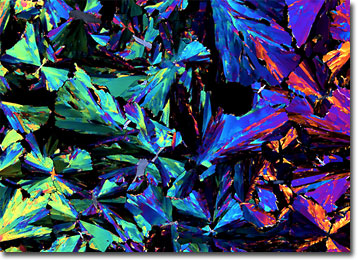Polarized Light Microscopy Digital Image Gallery
Coumarin
Coumarin is a naturally occurring substance that is a member of the heterocyclic class of organic compounds. Though present in a variety of plant species, coumarin was first identified in the tonka bean, a discovery made in 1820.

Well known for its vanilla-like fragrance, coumarin has been synthesized in the laboratory since 1868 and is commonly utilized in the production of perfumes. Despite its aromatic smell, however, the compound generally has a bitter taste. In fact, in lavender, sweet clover, strawberry, licorice, and other plants, coumarin is believed to act as form of defense against insects, which seem to be repelled by the taste of the substance. A coumarin derivative commonly known as warfarin is apparently even more distasteful, gaining use as a rat poison since the 1940s. This same compound was introduced for medical use in 1954 and has been widely utilized as an anticoagulant ever since.
Coumarin is utilized as a food additive in some countries, although it has been banned from such usage in the United States for several decades. Studies have indicated that the compound is potentially toxic to the liver when ingested, and some coumarin derivatives have been implicated in the deaths of cattle and other farm animals. These substances are commonly utilized for a wide array of other purposes, however, with little risk of ill health effects. Some of the products that coumarin and coumarin derivatives are found in include soaps, deodorants, tobacco, air fresheners, cosmetics, and dyes.
